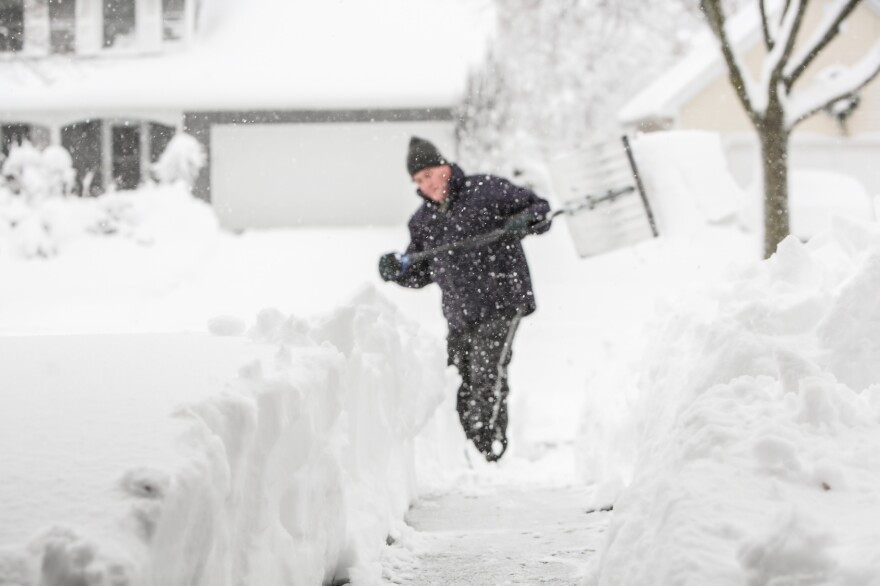Wisconsin has been hit hard this winter — from snowstorms to a polar vortex that brought dangerously cold temperatures and wind chills to the region. But even on the coldest days, with temperatures falling well below zero, a few dedicated runners or bikers will skip the gym and exercise outside.
Experts say frigid temperatures can increase your chances of cold weather injuries, from frostbite and hypothermia to aggravating heart, lung, and circulation issues. But even if we layer properly, how cold is too cold when it comes to exercising outdoors in the winter?
Dr. Sandra Hunter says that's a tricky question — and it's not as simple as temperature. Hunter is a professor in exercise science at the Marquette Department of Physical Therapy and a faculty fellow in the Office of Research and Innovation.
"There’s several factors, really, that can change the risk of cold weather injuries, which is really what you’re wanting to protect against," she notes. "And they really fit into preparedness, environmental factors and also individual characteristics of the person."
- A person's preparedness comes down to their clothing choices, proper hydration and food intake.
- Environmental factors include both the air temperature and the wind chill
- Individual characteristics vary from older adults, children, women, and those already at risk with heart or lung conditions such as asthma, according to Hunter.
The lack of preparation when it comes to clothing is probably one of the biggest factors that will predispose people to cold weather injury, says Hunter. But as long as you follow the general three-layer rule, she says you can safely exercise in really cold temperatures, even well below zero.
- Internal layer: This layer allows sweat to evaporate without absorption and is best with a moisture-wicking material such as polyester.
- Middle layer: Typically a fleece or wool shirt, this layer provides insulation for your body.
- External layer: This layer needs to be resistant against wind, water, but also allow evaporation of the internal moisture. A good jacket with zippers and ventilating abilities is best suited for cold weather exercise.
Exercise is actually a countermeasure to preventing hypothermia, says Hunter. But only if you do it with the right clothing and you take care to change out of that clothing immediately, especially if you've built up the sweat (outside or at the gym).
"It's that sweating and evaporation that will actually lower your body temperature," notes Hunter.
If your body temperature falls below 98 degrees, your chances of hypothermia increase dramatically. Hunter notes that a few signs you are hypothermic are severe shivering, loss of fine motor control, loss of major motor control, loss of speech, and even cardiac arrest that can lead to coma.
"When you start to shiver, you know your body is trying to fight off the cold and trying to keep your core body temperature at that nice 98 degrees," says Hunter.
Older adults, women, and children — smaller people in general — are at a higher risk for hypothermia since they're much more likely to lose heat more quickly, according to Hunter. "They've got less muscle mass, so they've got less ability for that metabolic heat to be generated," she explains.
Hunter also notes that frostbite is another interesting response of the body to keep its core temperature stable.
"What happens is the extremities ... if exposed, can start to freeze and the water within the skin and just under the skin can start to freeze and that's when you get frostbite."
"When your body gets cold, the vessels — particularly in the periphery in your fingers, hands, feet, arms — start to constrict and they narrow. That's the body's response to try and get that warm blood to the core to keep your body's temperature regulated," Hunter explains. "What happens is the extremities ... if exposed, can start to freeze and the water within the skin and just under the skin can start to freeze and that's when you get frostbite."
Hunter notes a simple way to avoid frostbite is to cover all extremities — wear gloves, masks, scarves, and thick socks and footwear. One of the first signs of frostbite is pain and numbness in your fingers, so be careful to warm up your extremities as soon as you notice it.

Even if most people do not make a habit of running outside in the winter, there is one exercise most homeowners have to participate in this winter: shoveling snow.
"It's also now established that there's a higher rate of heart attacks, particularly in men, after heavy snowfalls — and that's associated with snow shoveling," says Hunter.
Snow shoveling can raise your heart rate and blood pressure more quickly and dramatically than other types of exercises, according to Hunter. And it requires heavy use of the arms, which can be strenuous for some. If you are already at risk of heart disease or have asthma, the cold environment and construction of blood vessels can increase your predisposition for injury.
We've learned of the first fatality due to the cold where a man collapsed in his garage after shoveling. We worked closely w/Milwaukee County Homeless Outreach Team to create this handout, which is applicable to anyone going outside the next few days. #staysafe pic.twitter.com/LjvwWgqYot
— NWS Milwaukee (@NWSMilwaukee) January 29, 2019
"But probably one of the main factors in combination with these other factors is that often these shovelers are typically sedentary," notes Hunter. "So, suddenly they're asking their bodies to perform this intense exercise in the upper body, which creates greater strain on the body ... so it just predisposes them to more heart attacks."
Hunter says that giving people an exact temperature where it is safe to exercise outdoors in winter would be "irresponsible," since so many factors can influence a person's tolerance. However, she says if everyone is prepared and healthy, just keep your outdoor activities to your comfort level within reason.






